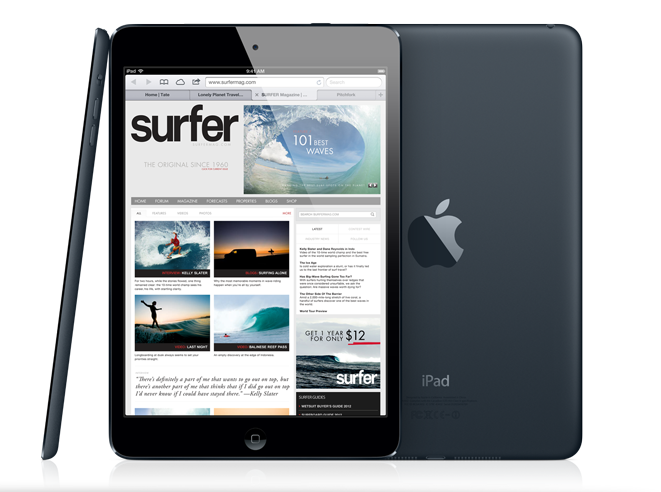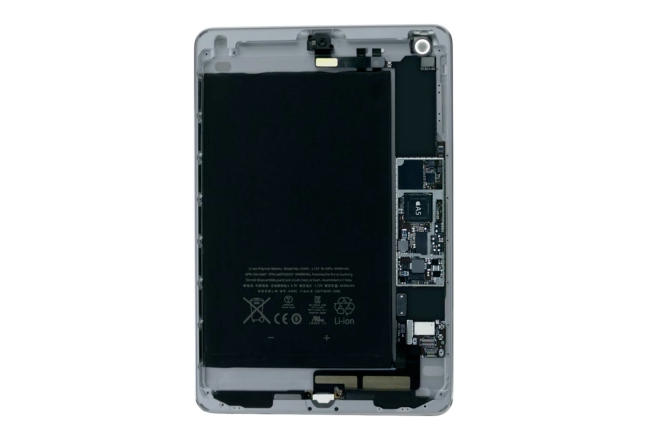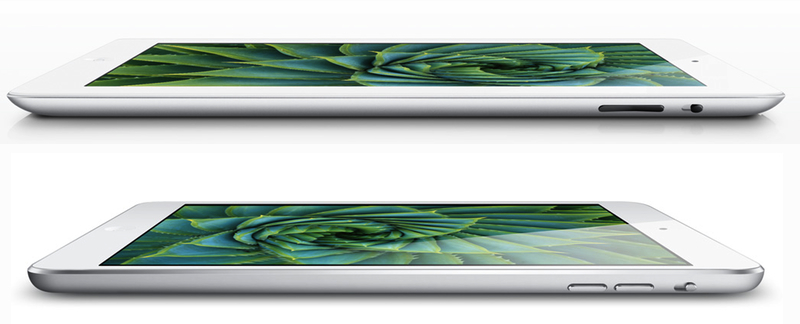The iPad mini looks good. Perhaps not iPhone 5 nice, but certainly “good” in my opinion.
I’ve been reading and thinking about the iPad mini. Now I’ve got some questions.
On the edge
After I took the time to look at the official press photos, my first thought was that the front of the device – with those chamfers, as Apple likes to call them these days – looked better than the back. The highly rounded edges, to me, look a little chubby. I think there’s a simple engineering decision behind the less tapered edges of the iPad mini: they give Apple those few extra millimeters that allow the company to fit this into the unibody chassis:
See how the logic board is placed on the right side. In devices like the iPad mini, miniaturization is measured in microns. Every part of a millimeter counts. For instance, the iPad mini is the second thinnest iOS device after the new iPod touch. It is the thinnest among all iPhones and iPads:
- iPod touch: 6.1mm
- iPad mini: 7.2mm
- iPhone 5: 7.6mm
- iPad 2: 8.8mm
- iPhone 4S: 9.3mm
- iPad 4: 9.4mm
The 10” iPad is actually the thickest, but because its edges taper on every side, it still seems (and feels) fairly thin (but not light). It is my assumption that the iPad mini will feel very light, but not as thin as it really is due to the less pronounced tapered edges. In fact, Jacqui Cheng of Ars Technica writes:
The iPad mini isn’t exactly like the full-sized iPad, though. For one, it comes off as a bit thicker. And even though the back of the iPad mini is the same silver/carbon aluminum as that on the back of the iPhone 5, it felt a little plasticky in my hand.
Tapered edges contribute to the style and overall feel of the device. I think this comes off more in a device like the iPad, which we hold differently than an iPhone – this is the reason why I’ve always thought the tapered iPod touch looked a bit out of place. The iPad mini, despite its remarkable thinness, may come off as thicker due to the rounded edges. This photo from The Verge is a good example: here’s the iPad 4 with (roughly) the same angle.
Just compare the profile of the mini to the iPad’s one:
Even in Apple’s promotional images (which may have incorrect proportions), the Retina iPad looks more stylish to me.
I think Apple went this route to fit everything into this first version. In choosing between display, features, and making the thinnest device possible, they chose to make an actual iPad with a 7.9-inch that doesn’t compromise on any feature. It is an iPad. Concentrated.
As their process improves, they’ll sell a thinner iPad mini as a substantial upgrade. Even more portable.
On the flip side, maybe a device like the iPad mini isn’t meant to taper at all, because there’s not so much space in the flat back. Maybe Apple found out that a smaller iPad felt wrong with tapered edges. I still think it has more to do with space.
I guess, come next year with a new iPad mini, we’ll look at the first mini just like we look at the original iPad: damn that thing is fat. It’ll be interesting to see how the design of the mini’s edges will evolve as it gets below the 7mm threshold.
I’m not saying the device looks cheap, though. In fact, judging only from photos and videos, I like it, especially the front. I just believe the Retina iPad’s profile looks better. But the ultimate test will be holding the mini for hours and see if the rounded edges can turn out to be a smart decision.
Retina
I don’t have perfect eyesight, so I got used to Retina displays quickly. I upgraded my iPhone and iPad to Retina without thinking about it twice. LCDs aren’t good for eyesight, but Retina undoubtedly puts less strain on the eyes. This is why I think I won’t be able to adjust to the non-Retina screen of the iPad mini.
With the same resolution of the iPad 1/2 in a smaller space, the device’s PPI count goes up a bit (from 132 to 163), but not exceptionally so. Gruber tried a demo unit in San Jose, and already said it doesn’t look nearly as nice as Retina. After reading a bunch of hands-on articles, it is my understanding that the mini looks like a brighter, slightly crisper iPhone 3GS.
Will the “new shiny” factor compensate for lack of Retina? Will the device’s usefulness outweigh the annoyance of fuzzy text?
The price
Aside from the fact that, for some reason, Apple prices are always plainly converted from US Dollars to Euros ($329 > €329), I don’t think the iPad mini’s price will be an “issue”.
The press wants issues. People want things that work, at a reasonable price.
The iPad mini price is reasonable. Many were hoping for $299, but Apple is asking for $30 more. Do you think people that wanted a smaller iPad will be scared away by $30?
But let’s play devil’s advocate and consider this pricing strategy. Steve Streza has a point when he argues that there’s some inconsistency going on, if only because the more SKUs Apple introduces, the more it’ll get confusing for us to keep track of.
So here’s a different perspective I was discussing today with some friends. When you buy a base-model iPad, if you add an accessory, say a Smart Cover, you’re immediately in $500 territory. With the iPad mini, even if you add an accessory – as most buyers do – you’ll still be in the range of $300. That’s a powerful psychological barrier – we humans are strange creatures when it comes to prices. For most people, a $360 purchase versus a $500 one sounds like a great deal – hey, you’re saving $200. Except you’re not – you’re saving $150. “I’m still into the $300 range” is a more powerful argument than you think.
Consider the opposite scenario. Apple prices the iPad mini at $299, and consumers are happy – hey, it’s below $300. But then they add a Smart Cover and the illusion is broken – you’re spending $300 now.
Never break the illusion.
Curiosity
Like I said above, however, there’s only so much price can do to scare off or attract buyers. If people want an iPad mini, stay assured – an iPad mini they’ll get. Apple produced this new iPad exactly for people who value portability and weight. I only mentioned price to offer an additional perspective some haven’t thought about.
The way I see it, there are two main categories of possible iPad mini users:
- People who have a problem with the 10” iPad
- People who don’t have an iPad.
In both cases, the simple question to ask in regards to the purchase would be: why the mini?
For users new to the iPad ecosystem, it’s fairly simple: pick the one you like the most. Those who don’t own an iPad now have more choice, because Apple believed demand was now high enough to justify the release of a variation. With the iPad mini, every iOS device – with the exception of the Apple TV outsider – now offers more choice.
It’s more difficult for existing iPad users. Should you get a new iPad mini and replace the old one? Or should you get a mini in addition to the 10“ iPad? Is the iPad a computer – can the mini be a laptop and the Retina iPad a ”home tablet”?
I don’t have the answers.
If you happen to be like me – a “geek” who’s discovering the pleasure of increasingly using the iPad as a “work device” instead of the usual MacBook – choice becomes a tough call. You’re curious to try out the new iPad mini, but, let’s face it, the iPad 3 is still a great device. I believe I’m not alone in being more curious about the mini than the iPad 4.
I don’t see the reason why I should get an iPad mini 4G in addition to my existing iPad 3 with 4G – nor can I justify the expense of another data plan. So should I get the base model mini with just WiFi? I would, but what if I like it – will I have to rely on Personal Hotspot all the time? Will the smaller landscape keyboard hinder the productivity angle for a writer like me? And the Retina – what about the display? If I like it, am I going to regret not waiting until the next version, now that I’m used to my Retina iPad 3?
And so forth.
For work or leisure, I can’t help but being curious about the iPad mini. There have been times I wished I had a smaller, more portable iPad.
Do I need the iPad mini? I don’t know. Maybe.
So here’s my strategy. I will get an iPad mini for my girlfriend and see how it goes from there.




